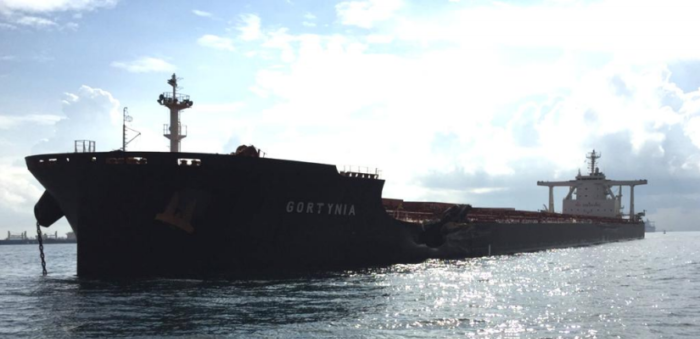Transport Malta released its report about the 17 May 2017 accident, when Gortynia, a fully laden cape size bulk carrier, collided with the bulk carrier DZ Qingdao in Singapore Strait. The collision happened in the East-bound deep water route of the traffic separation scheme (TSS) off Batu Berhanti. Gortynia sustained major damage to her port side forward ballast tanks, while DZ Qingdao also sustained major damages to her bow.
The incident
Gortynia departed Saldanha Bay, South Africa at 1400 on 26 April 2017. The vessel had loaded 179,554 mt of iron ore bound for China. Since the vessel was scheduled to stop at Singapore, the master followed a passage plan that took the vessel past One Fathom Bank into the Malacca Strait and
Singapore.
[smlsubform prepend=”GET THE SAFETY4SEA IN YOUR INBOX!” showname=false emailtxt=”” emailholder=”Enter your email address” showsubmit=true submittxt=”Submit” jsthanks=false thankyou=”Thank you for subscribing to our mailing list”]
At about 2249, Gortynia entered the deep water route in the Singapore main strait and her engine was set at full ahead. At about 0015, the chief mate noticed DZ Qingdao and African Loon on the S-band radar that he was monitoring on 3 nautical mile (nm) range. He acquired both targets in the AIS mode.
The AIS plot of African Loon showed that it would pass Gortynia at about 4 cables on the port side and it was assumed by the chief mate that DZ Qingdao would also pass clear as both vessels were following each other in the West bound traffic lane.
However, the AIS vector on DZ Qingdao disappeared. The AIS symbol reappeared around a little later, but had an incorrect heading and no directional vector.
Soon after, the bridge team members onboard Gortynia became aware of DZ Qingdao heading towards them. The master ordered the engine to ‘half ahead’ and the helm to starboard 20°, followed by ‘dead slow ahead’ and wheel amidships. Although not heard clearly on Gortynia’s VDR playback, it appeared that DZ Qingdao tried to alert Gortynia over the VHF by asking the vessel to keep clear of them.
Gortynia’s master ordered ‘stop engine’ and a few seconds later ordered the wheel to hard to starboard. The master then ordered that the main engine is progressively set to ‘full astern’, but this did not prevent both vessels from colliding with each. The two vessels remained in contact with each other for about a minute, causing extensive damage to their structures.
Probable cause
The change in DZ Qingdao’s heading and speed meant that she was at risk of collision with Gortynia as they approached each other. This change
was not noted by Gortynia as the bridge team were only monitoring AIS targets on its radars, and with the loss of power on board DZ Qingdao, the AIS transmission ceased, causing the loss of the AIS plot.
DZ Qingdao did not warn the surrounding vessels that she was not under command and as a result when the change in heading was detected by Gortynia, at a very late stage, this did not allow her to effectively avoid the collision.
Moreover, Transport Malta noted the following:
- The perception of the situation which the crew members on the bridge of Gorthinia had, did not reflect the situation outside the bridge window;
- DZ Qingdao was a vessel not under command but did not display the appropriate signals;
- DZ Qingdao’s track trail indicated on the radar screen that the vessel’s heading had changed but this was also not investigated by the crew
members; - The reasons for the missed information was distraction;
Recommendations
After the investigation, Transport Malta recommended Eastern Mediterranean the following:
- Review the lessons highlighted in this investigation and circulate to all vessels in the fleet;
- Review the procedures on collision avoidance and reinforce the requirement of radar plotting by ARPA rather than reliance on AIS;
- Review the procedures on collision avoidance and reinforce the requirement of radar plotting by ARPA;
- Review their bridge team management and training in light of the findings highlighted in this investigation;
- Undertake a series of navigation audits on board its managed vessels to ensure company bridge requirements and procedures are being carried out.






























































